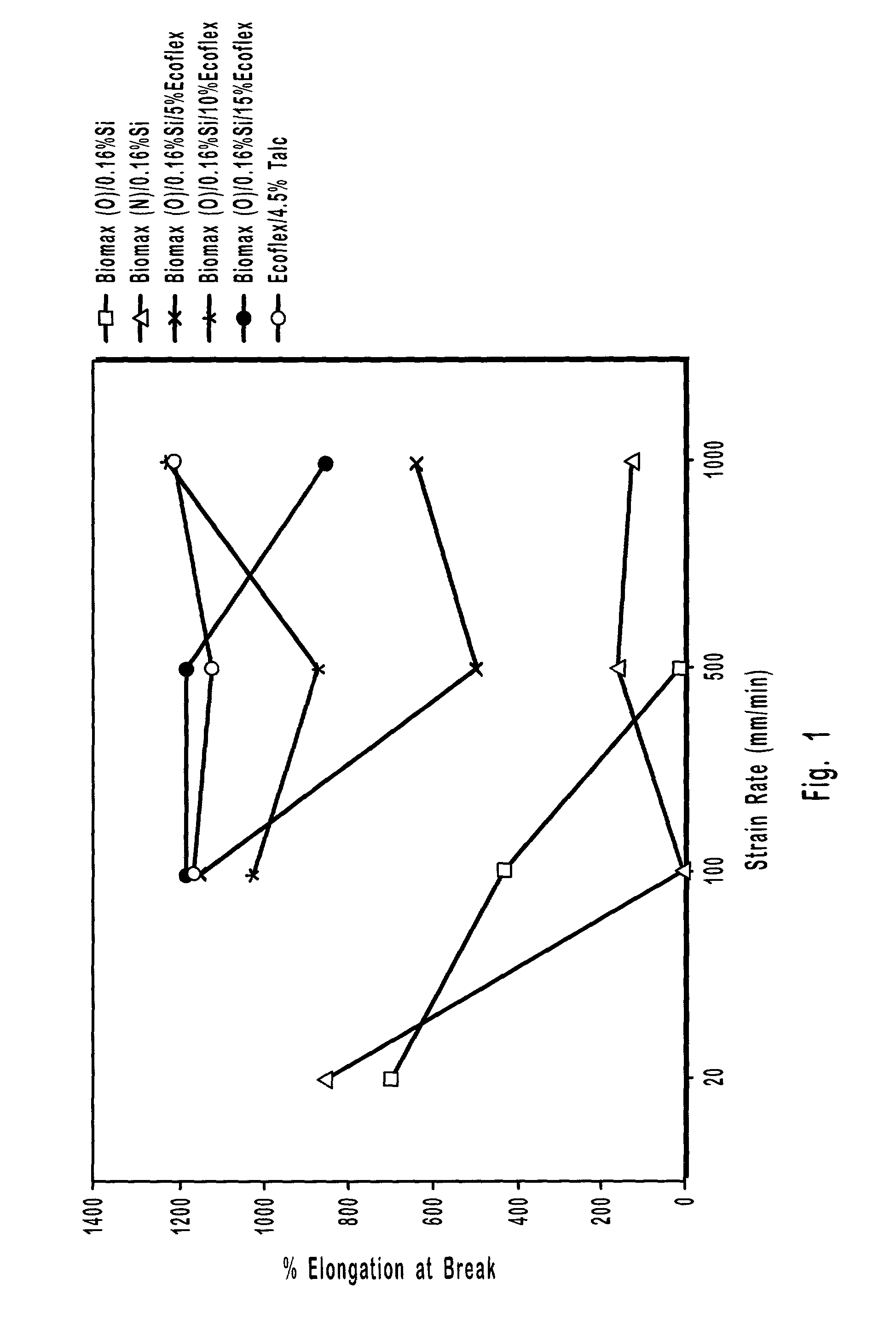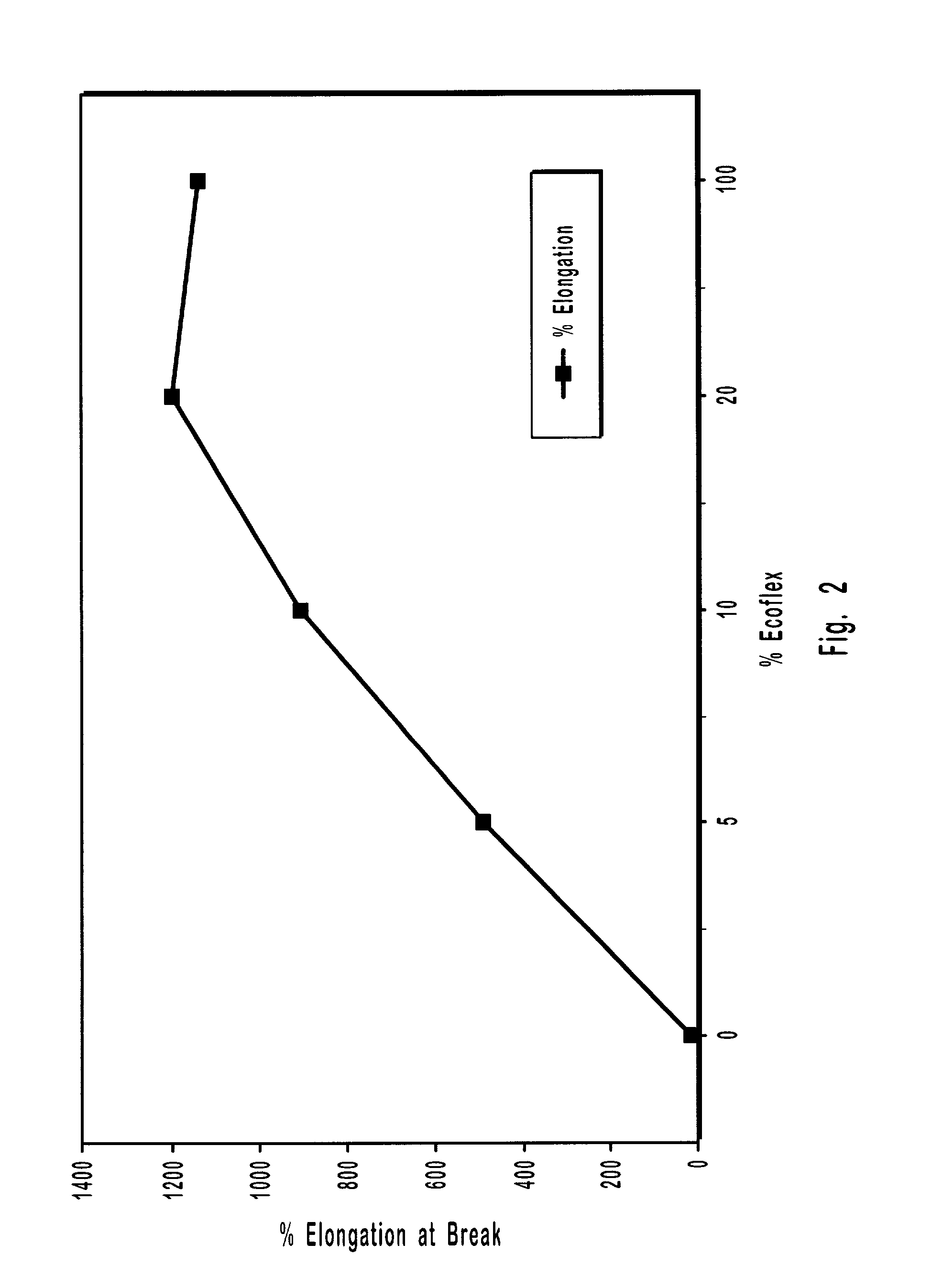Biodegradable films and sheets suitable for use as coatings, wraps and packaging materials
a biodegradable film and film technology, applied in the direction of synthetic resin layered products, applications, coatings, etc., can solve the problems of poor dead-fold properties, difficult, or even impossible, to identify one single polymer or copolymer which meets,
- Summary
- Abstract
- Description
- Claims
- Application Information
AI Technical Summary
Benefits of technology
Problems solved by technology
Method used
Image
Examples
examples 1-3
[0176] Films were manufactured from biodegradable polymer blends having the following mix designs, with the concentrations being expressed in terms of weight percent of the entire polymer blend:
1 Example Biomax 6926 Ecoflex-F SiO.sub.2 1 94.84% 5% 0.16% 2 89.84% 10% 0.16% 3 79.84% 20% 0.16%
[0177] The foregoing polymer blends were blended and blown into films at Gemini Plastics, located in Maywood, Calif., using DuPont supplied BIOMAX 6926 (both new and old lots), a silica master batch in BIOMAX 6926 base resin supplied by DuPont, and ECOFLEX-F resin obtained from BASF. The films were blown using a Gemini film blowing extruder (L / D 24 / 1) equipped with a 2 inch barrier mixing screw containing a Maddock shear mixing tip, and a 4 inch diameter annular die with a die gap of 0.032-0.035".
[0178] Even though a typical quantity of silica antiblock was used (i.e., 0.16%), significant blocking of the film was observed for the film made using the mix design of Example 3 (i. e. 20% ECOFLEX); how...
examples 4-5
[0187] Films were manufactured from biodegradable polymer blends having the following mix designs, with the concentrations being expressed in terms of weight percent of the entire polymer blends:
2 Example Biomax 6926 Ecoflex-F Talc 4 79.7% 16.7% 3.6% 5 76.7% 16.7% 6.6%
[0188] The films were blown using a Gemini film blowing extruder (L / D 24 / 1) equipped with a 2 inch barrier mixing screw containing a Maddock shear mixing tip, and a 4 inch diameter annular die with a die gap of 0.032-0.035". The film of Example 5 had better dead-fold properties than the film of Example 4, which might be attributable to the higher concentration of talc within the blend used in Example 5.
example 6
[0189] A film was manufactured from a biodegradable polymer blend having the following mix design, with the concentration being expressed in terms of weight percent of the entire polymer blend:
3 ECOFLEX-F 20% Thermoplastic Starch 50% Polylactic Acid 15% Inorganic Filler 15%
[0190] The Thermoplastic Starch was obtained from Biotec Biologische Natuverpackungen GmbH & Co., KG ("Biotec"), located in Emmerich, Germany. The polylactic acid was obtained from Cargill-Dow Polymers, LLC, located in Midland, Mich., USA. The inorganic filler was calcium carbonate obtained from OMYA, division Pluess-Staufer AG, located in Oftringen, Switzerland.
[0191] The foregoing blend was manufactured and blown into sheets using a proprietary extrusion line thermoplastic starch extrusion / film blowing apparatus manufactured and assembled specifically for Biotec. In particular, the extrusion / film blowing apparatus was manufactured by Dr. Collin GmbH, located in Ebersberg, Germany. A detailed description of an ex...
PUM
| Property | Measurement | Unit |
|---|---|---|
| glass transition temperature | aaaaa | aaaaa |
| glass transition temperature | aaaaa | aaaaa |
| glass transition temperature | aaaaa | aaaaa |
Abstract
Description
Claims
Application Information
 Login to View More
Login to View More - R&D
- Intellectual Property
- Life Sciences
- Materials
- Tech Scout
- Unparalleled Data Quality
- Higher Quality Content
- 60% Fewer Hallucinations
Browse by: Latest US Patents, China's latest patents, Technical Efficacy Thesaurus, Application Domain, Technology Topic, Popular Technical Reports.
© 2025 PatSnap. All rights reserved.Legal|Privacy policy|Modern Slavery Act Transparency Statement|Sitemap|About US| Contact US: help@patsnap.com



